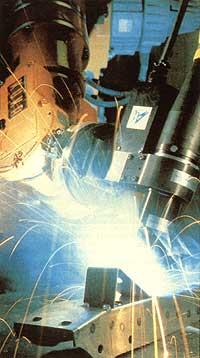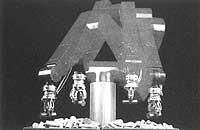Robot vision status

Robots, among others, were born to replace people in some tasks. To design the skeleton of robots it was necessary to rely on something. The model on which it was based was the human body. Therefore, the skeleton of robots reminds us of one or more parts of our body. At first it can be said that the robot was a blind, deaf and tactless person.
Robots have been completed and improved according to needs. Initially the number of movements began. Then we worked on sensors and we are currently working on the view. Of course, the human arm was taken as a model to adjust the number of movements and the sensors were based on human touch. Already, as a reader, you will have imagined what part of our body has been taken as a model of visual work: the eye, of course.
But how can the robot see it?
First you have to take the image of what you want to see (this is done through a TV camera). And then the robot must identify what is seen (this is done by computer). Finally, once the image has been identified, the computer will direct orders of one type or another to the robot.
The second of the three mentioned steps is the one that generates major headaches. However, some techniques have already begun to apply and in the following lines we will make a leap to this step.
If we have said before that the human eye is an example, it must be said that the eye is the most known organ of the body (scientifically). This knowledge has been used by technicians.
What we see from the eyes goes to the brain. If it can be associated with an image stored in it, we will be known and therefore know what to do. However, if it is not possible to relate what is seen to what is accumulated in the brain, it will be unknown to us and therefore we cannot give reliable answers. However, the characteristics of the images that are unknown to us can make them known by learning from another place or from someone. We will save the information learned in the brain, so if we see the image that was unknown to us in a next round we will be known. In this sense, we can say that knowing what is seen is about comparing the image with the accumulated information and it is about accumulating experiences of knowledge.
The concept introduced in this process is that of intelligence. That is, in order to work the field of vision, it is also necessary to work on intelligence.

When identifying an object, problems begin immediately. One of the most elementary is that two-dimensional images that give views of a three-dimensional object usually have nothing to do with the same object.
One of the simplest identification examples is knowing the edges of an image. If the edges appear in an image, it is because there are different shades or intensities of light. This usually occurs in object environments. Current computer techniques are not able to identify objects by detecting variations in light intensity. Numerical analysis methods are those used for edge detection.
Laser scanners are used for surface detection. Once all these measurements have been made, the analysis of the collected data is the greatest challenge for technicians.
We will not explain what mathematical and technical path technicians use. As for the current issue, we will say that new discoveries are being made every month.
Finally, this article aims to present an idea of a concept explained in a somber way: "robots need a level of intelligence to be able to see them, even if it is very primary."
Undoubtedly, this level of intelligence will increase over time, so robots will replace a growing number of people. And not only in productive processes, but in any action of our lives. So what role will we play in this world? What sets us apart from smart machines? Perhaps the possibilities of our mind?
Buletina
Bidali zure helbide elektronikoa eta jaso asteroko buletina zure sarrera-ontzian











